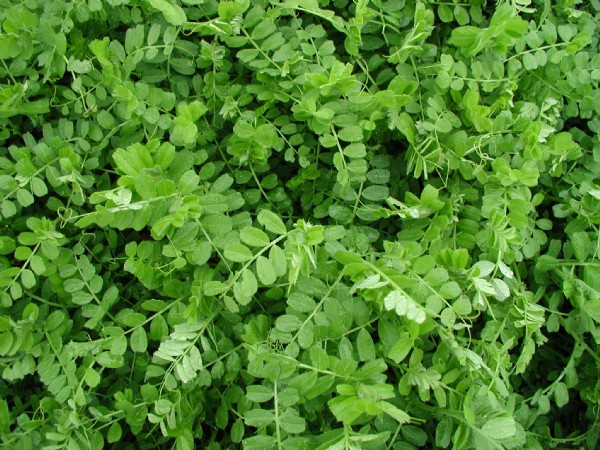

The field was silaged in 1999 and whilst it provided some bulk the forage was lacking in quality. Aftermath grazing was sour and disliked by the grazing animals. Mark decided to improve the field by reseeding. The old ley received 8 tonnes of FYM and was ploughed in early March 2000. Unfortunately it was ploughed a little too deep and this meant some sub-soil and boulders were brought to the surface. After three days of boulder picking and the application of two tonnes of lime Mark was ready to prepare the seedbed. The seeds were sown during the last week of March.
A straightforward red clover based ley for high quality silage production was ordered from Cotswold Seeds. A three-year mixture containing 3 kg Milvus red clover and 9 kg hybrid ryegrass was chosen. Mark, looking for quick production and concerned that the docks may reappear in the new ley decided to add 15 kg of vetches as a cover crop to the ley mixture to provide weed competition. The seeds were mixed and broadcast together through a Varispreader and harrowed lightly before being heavily rolled.
Why Vetches?
The vetches fit well, as they are aggressive and compatible with key mixtures. They bulk up quickly but have an open enough growth habit to allow the ley mixture underneath sufficient room to establish. Being a legume vetches have high protein content and provide the establishment ley with free nitrogen. Whilst the red clover does the same it takes a little longer to establish before fixing nitrogen to its full potential.
Fourteen Weeks Later
Royal Show week, and the mower went through the gate. The vetches had just started to flower and were about 30” high, the grass was all leaf and not stalk – a little like second cut silage. The crop was cut in glorious sunshine, spread immediately and left. (The stomata remain open for only 90 minutes and it is during this time that the maximum amount of water can be lost). Two further ‘kicks’ over the next 36 hours and it was baled. The weather was stormy and unfortunately the DM content of the silage was only 22 per cent. However, with D-value 69, ME 11.1 and CP 13.6 all was not lost. The low protein figure was a reflection of the season and was experienced by many farmers last year.
Six weeks later and Mark was mowing again. Being an annual the vetches had now gone. Now it was the red clover and ryegrass making their contribution. This cut taken at the end of August had a DM content of 29%, a D-value of 68, an ME of 10.7 and an improved protein of 15.3%.
Lessons Learnt
Adding a vetch cover crop to a ley mixture is good way to boost yields in the short term and provide completion to weeds. At Gear Farm the result was excellent. However, the vetch inclusion rate of 15kg per acre will be lowered to 10kg in future. The reason is that it may be possible to adversely affect the establishment of the ley with a sowing rate that is too high.
Ley mixtures sown in the autumn can also benefit from a cover crop of vetches. It is important to use a winter hardy variety.
by Ian Wilkinson of Cotswold Seeds
Date Posted: 30th March 2017



